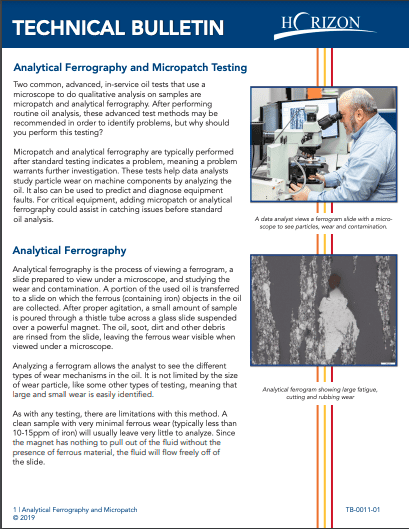When to Add Micropatch or Analytical Ferrography

Micropatch and Analytical Ferrography
Micropatch and Analytical Ferrography are typically performed after standard testing indicates a problem, meaning a problem warrants further investigation. These tests help data analysts study particle wear on machine components by visually analyzing the oil’s captured deposits. It may also be used to predict and diagnose equipment faults.
Catch What Oil Analysis Cannot
Ideally, mission-critical components should receive Micropatch or Analytical Ferrography testing on a regular basis to identify trends similar to standard oil analysis. Since these methods are qualitative and visual tests, an analyst may identify precursors to failure modes. This includes signs such as metallic spheres (which point to early signs of fatigue) or thermal discoloration (signs of excessive heat in localized areas), which would not be able be detectable in routine elemental analysis (ASTM D5185).
Signs to Add Micropatch or Analytical Ferrography
In summary, either test is a microscopic analysis of insoluble deposits in the sample, but both tests are not always appropriate. The Analytical Ferrography is recommended when a certain detection of iron is present from elemental analysis results or high ferrous density from particle quantifier testing. If the extrapolated limits identify an abnormal level, this test is used to determine wear mode (corrosive, fatigue, fretting, etc.) and condition severity based on the size, shape, and frequency of the respective deposits. The elemental analysis will only provide detection of particles sizing smaller than approximately ten microns. The microscope test will not discriminate captured wear metals with respect to the particle size, and enough iron will also cause non-ferrous metals and/or contaminants to deposit as well. The ferrogram’s glass slide may also heat-treat if certain wear metal deposits are unidentifiable. Alloys will experience a variety of thermal discoloration at a certain temperature based on the metallic composition, which provides allowance for improved recommendations.
The Micropatch is a suitable choice when elevated non-ferrous wear metals or external contamination are present in the absence of a significant iron detection. One of the greatest benefits of this test is the membrane patch will capture essentially all insoluble deposits in the oil. However, the level of contamination from other sources (dirt, soot, environmental contaminants, etc.) has the potential to sway an analyst from this recommendation versus the Analytical Ferrography. If too much contamination is present or expected to be present, particle stacking may occur, and significant information may be lost due to an inability for visual identification. The Analytical Ferrography testing has available techniques which may be able to avoid this issue during interpretation.

Proven Impact. Proven Uptime. Proven Savings.
Let us prove it to you.




